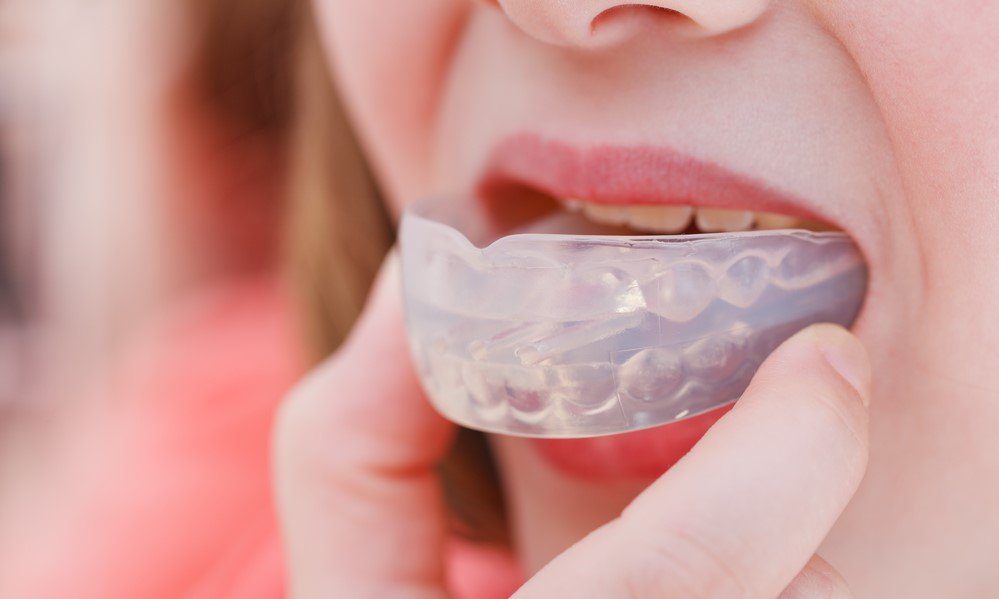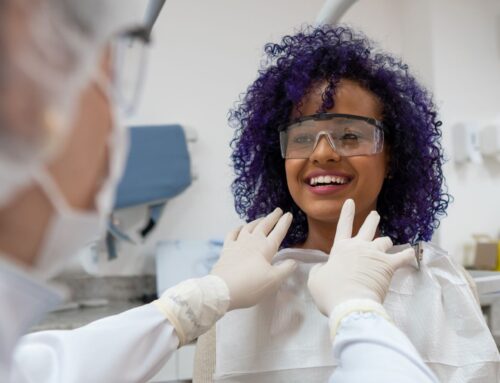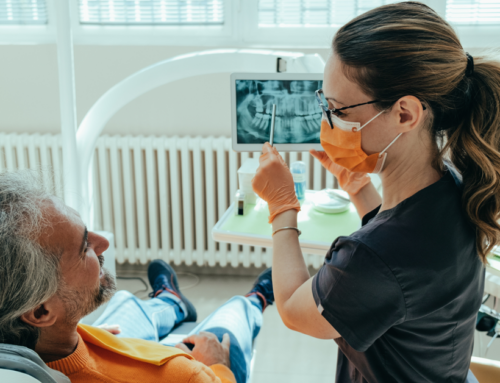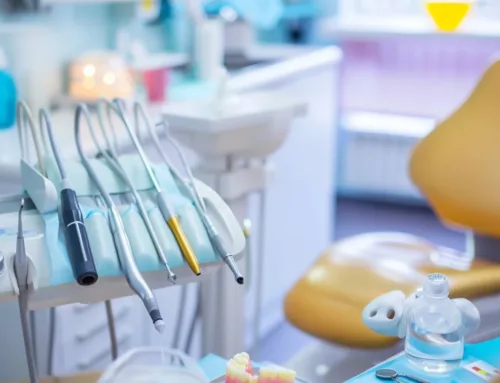What is a mouthguard? Choosing the Right Dental Mouthguard
You spend a lot of time and effort in making sure that your smile stays the way you want it, so when there are times that you need a bit of extra protection for your teeth, it’s important to make sure that you have the right mouthguard.
Mouthguards come in several different types and styles for a variety of applications, but the end goal is always the same; to make sure your teeth stay safe and straight. In this article, we’re going to explore the different reasons that you may need a mouthguard, and how the different materials used and the ways they are made help to determine what they are best suited for. In addition, you’ll learn how mouthguards are made to perfectly fit your mouth and how you can get the process started and obtain a mouthguard custom-fitted for your teeth.
Let’s start by taking a look at a few of the most common materials used in producing mouthguards for a wide range of uses and different levels of protection.
Materials Used in Mouthguards
Dental mouthguards can be made from many different types of materials, each with different properties that make them better suited to achieve a particular result or perform a specific function for the wearer. Some are harder and thinner, ideal for mouthguards that are less noticeable but offer less protection against impacts. Other mouthguards are made from softer and thicker materials, making them perfect for shock absorption, but that extra protection also makes them much more visible.
Thermoplastic Mouthguards
Thermoplastic is the material most often used in store-bought or over-the-counter mouthguards that are commonly referred to as ‘boil-and-bite’ mouthguards. The material is firm yet pliable, and usually around 3-4 mm thick. This thermoplastic material is designed to be heated up using hot water to make the material softer and able to be slightly re-molded using gentle bite pressure of the wearer, allowing a certain level of customization to the fit. Thermoplastic mouthguards can be found in many different colours, allowing the user to select the colour of their personal preference.
In general, thermoplastic mouthguards provide the most affordable option for sports protection, but they do not offer the same level of protection as professionally fitted custom sports mouthguards. Often, these mouthguards do not offer the most comfortable fit due to their limited sizing criteria, and as such are not often recommended by dentists or orthodontists. Instead, they will recommend a custom mouthguard made from more advanced materials that offers greater protection and a more comfortable fit.
Laminate Mouthguards
Multi-material mouthguards, also known as laminate mouthguards, are of higher quality than the thermoplastic variety. These are the types most often provided by dentists and can be molded to perfectly fit any smile for maximum comfort and protection. The laminate material is a combination of different layers, some softer and some firmer, in order to provide shock absorption and even pressure distribution for the best level of protection against impacts and potentially damaging forces.
Laminate materials can be made in virtually unlimited colour combinations, and some even offer elaborate designs and patterns in the materials. This allows the wearer to exhibit some personal choice in the look of their mouthguards, even so far as to coordinate with team jerseys, colours, and slogans.
Acrylic Mouthguards
For mouthguards that are intended to be worn during normal everyday activities, and not specifically for sports or physical activities, acrylic is usually the preferred material. Acrylic is light, rigid, and can be made to be transparent in order to be very subtle and less noticeable when worn. Acrylic mouthguards are commonly used in instances where shock absorption is less of a concern, but the intent is to maintain the position of the teeth over long periods of time.
Like the laminate style of mouthguards, acrylic mouthguards are custom-made by a dentist in order to precisely match the contours and shape of the wearer’s teeth. This helps ensure the position of each tooth is maintained exactly.
How are Mouthguards Made to Fit?
Unlike the simple process of heating up thermoplastic material to be pressed on to the teeth like the over-the-counter mouthguards, custom-fitted mouthguards have a much more precise method of manufacturing in order to provide the fit and protection that you need.
For both laminate and acrylic mouthguards, even though the materials are very different, the process is very similar at the beginning. It starts with a thorough dental examination and discussion with your dentist about what your needs are and what type of protection is required. Once they have determined the best type of mouthguard for you, they will take impressions and molds of your mouth in order to create a precise 3D model of your teeth and gums with which to make your mouthguard. Digital scanning and imaging technology may also be used to provide even more precise levels of detail in the process.
These molds and models are then used to create your mouthguard using different methods depending on the type of material being used for the mouthguard itself. For acrylic mouthguards or sports mouthguards made from a single layer of material, vacuum-forming is often used. In vacuum-forming, the sheet of material is heated and then stretched over the mold using vacuum-pressure to stretch the material and pull it as close as possible to the contours of your teeth and gums model.
Once the vacuum forming is completed, excess material is trimmed off and sharp edges sanded and shaped to be smooth and unobtrusive. The mouthguard is then ready for a test fitting on your teeth, at which time adjustments or additional shaping or trimming may be needed to get the perfect fit.
For mouthguards that use a layered laminate material, instead of using vacuum-forming, a special pressure machine is used to heat and fuse the layers of material together and press them down over the mold of your teeth. These laminate mouthguards offer the best combination of comfort and protection for the wearer and also demonstrate less deformation over time for a longer useful life.
Although most mouthguard materials are typically used for the same general purposes, there are instances where some of these materials may be preferred for applications that are outside of the normal usage. For example, if a patient is experiencing negative effects from tooth grinding, a nighttime mouthguard made from hard acrylic may not provide the optimum solution. In this case, a softer material may be used to reduce pressure and prevent grinding.
Now, we will examine some of the most common uses for mouthguards to be recommended for patients by their dentist.
Sleep Mouthguards
Grinding and clenching of teeth during sleep is a common problem that affects many patients. To provide relief and offer a solution to these problems, dentists often prescribe a nightguard, which is a special type of mouthguard to be worn at night time. These mouthguards are generally made from a firm but slightly pliable material that absorbs the pressure of clenching thereby relieving headaches and reducing soreness and strain in the jaw and surrounding muscles. These mouthguards also provide a barrier between the teeth, eliminating the wear that occurs as a result of tooth grinding.
Sports Mouthguards
As to be expected, most mouthguards are used for the purpose of protecting the teeth and jaw during sports and aggressive physical activities. Sports mouthguards are made from multiple types of shock-absorbing materials and are required for contact sports such as hockey, football, rugby, lacrosse, wrestling, boxing, martial arts, and many more.
If you are engaging in any of these activities, it is highly recommended that you always wear the proper protective gear at all times, and that includes protection for your teeth in the form of a custom-fitted sports mouthguard.
Post-Orthodontic Mouthguards
Another common reason for mouthguards to be used is to help ensure that the results obtained through orthodontic treatments are maintained once the appliances have been removed and the treatment is completed. Most of the time these post-orthodontic mouthguards are of the clear acrylic variety, as they can be worn during normal daily routines and are not noticeable. These mouthguards are simple to remove and replace for activities such as eating or drinking and are easy to clean and maintain as part of your normal oral health routines.
Start the Process of Obtaining a Custom Mouthguard
If you’re in need of the protection that a mouthguard can provide, or simply want to take steps to ensure that your teeth stay straight and in perfect shape, then the process starts with a simple consultation and discussion with your dentist.
Contact the team here at Georgian Dental® today to arrange for your appointment and we will be glad to review all the options you have available and provide you with a recommendation. From there, we will work with you to ensure that your custom mouthguard fits perfectly and offers you the best in protection and comfort for your smile.
Appointment Request
If you’re interested in any of our procedures, and would like to meet with one of our dentists to discuss options, costs and get additional information, complete this short form and we’ll give you a call to arrange for a no-obligation appointment at our Barrie clinic.










